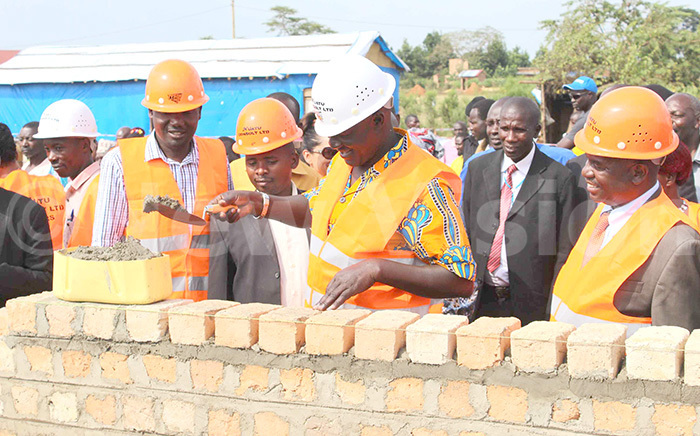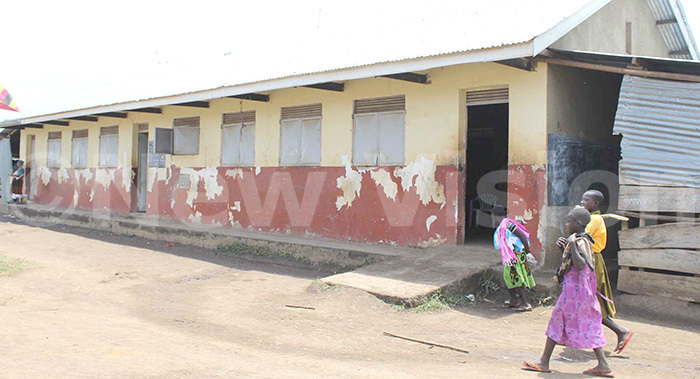Two classrooms for 700 pupils
'Whereas this school is surrounded by farmers who always pray for rainfall, we as a school, are always praying that it does not rain or at least it rains at night so that our children can learn'
PIC: Pupils of St Andrews Nyairongo Primary School in Kikube District celebrating during the commissioning of the construction of new classroom blocks on August 8, 2018.(Credit: Geoffrey Mutegeki)
It is 10:37am in Nyakirongo village in Kabwoya sub-county, Kikube district. Pupils of St Andrews Primary School are lining along the road to welcome visitors to their school. The sun is shining hot, but the jovial pupils are singing loudly as they wait for more visitors to come.
It is a day to celebrate a new era. The school is receiving new classrooms that will save the pupils from studying under the trees and sharing classes.
St Andrews has a population of 646 pupils, but has only two classrooms that were constructed by the Government in 2015.
"They always study from under the tree while some classes share the same room. They study while facing in different directions," says Hamidu, the headteacher of St Andrews.
The school started in 2002 and has been struggling to accommodate the ever increasing number of pupils.
Some classes, due to lack of enough classrooms, study from under trees and whenever it rains, there is no learning.
"Whereas this school is surrounded by farmers who always pray for rainfall, we as a school, are always praying that it does not rain or at least it rains at night so that our children can learn,"
Apart from few classrooms, the school also lacks enough latrines.
"Teachers and pupils use the same latrines. They are only three and sometimes pupils line up for them," Hamidu says.

The situation is no different at Kibale Parents Primary School where pupils are also sharing classrooms for lack of enough buildings.
"Primary six and Seven always use the same classroom while other learners study from under trees or in wooden makeshifts constructed by parents"
The schools also lack water and pupils have to walk long distances to access it.
"We walk for about two kilometres to the swamp where we fetch water. It is very far and tiring," reveals Hanifer Ainembabazi.
We started from a tree, but now have these two classrooms which are shared by all the classes. Some pupils study from under a tree and whenever it rains, there is no learning.
But with the construction of six more classrooms, the school is slated to have at least enough classrooms to accommodate the currently overwhelming numbers.
Through parents' efforts, the school had constructed two wooden classrooms. The teachers and pupils share the only three latrines.
The school lacks water and pupils have to walk about a kilometre to get water from a swamp.
"We walk for about two kilometers to the swamp, where we fetch water. It is very far and tiring," reveals Hanifer Ainembabazi.
The good news is that all this will be history since government has come up with a special program known as Development Response to Displacement Impact Project (DRDIP) aimed at aiding these schools mainly in refugee hosting districts.
On Wednesday, Musa Ecweru, the state minister for disaster preparedness and refugees, launched the project in Kikube district with construction of new classroom blocks at St Andrews Nyairongo PS.
"I always feel embarrassed whenever I pass here with aid to the refugees yet the host communities are suffering. But now we have come to support you and say thank you for hosting refugees," Ecweru said.
Under the DRDIP which is running in eleven refugee hosting districts, focused on improving the livelihoods of the host communities through improvement of infrastructure, environmental protection.
Schools will be supported with classroom blocks, desks, latrines and water tanks.
Funded by the World Bank, the three schools in Kikube district will share Shs 1bn for the construction of these classrooms.
Each of the benefiting schools will receive six classrooms equipped with desks, and lightening conductors.
Also three blocks of 5 stance latrines and two 10,000 water tanks will also be part of the project on the schools.
The same will be constructed in three other schools in Kiryandongo district at a cost of sh995m.
The schools in Kiryandongo include, Bweyale Church of Uganda Primary School, Bweyale Public Primary School and Mutunda Primary School.
According the director DRDIP, Robert Limlim, DRDIP is a government Project under the Office of the Prime Minister that will provide development and direct income support to the poor and vulnerable within refugee hosting districts in Uganda.
"We are not only supporting schools but also road infrastructure, environmental protection, and livelihood improvement," Limlim says.
He notes that the development objective of DRDIP is to improve access to basic social services, expand economic opportunities and enhance environmental management in refugee hosting districts.

PIC: The two only classrooms at St. Andrews Nyairongo Primary School in Kikube district